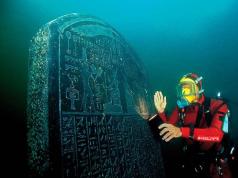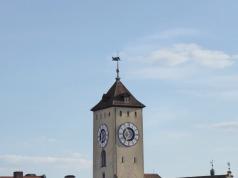Catacombs of Kom el-Shukafa located in the southwest of Alexandria in modern Egypt and is the Arabic translation of the ancient Greek name Lofus Kiram aikos, which means "hill of fragments" or "shards". It is a multi-profile labyrinth of 3 levels, inside of which there are dozens of chambers decorated with sculptural pillars and other monuments, religious symbols. It was a necropolis for the burial of the dead in pagan times. Niches in which there are stone sarcophagi are cut down right in the rock. As well as a memorial hall for the relatives of the deceased, decorated in the Roman style. A stunning piece of architecture. Presumably, construction began in the 1st-2nd century AD. and was completely accidentally discovered in 1900 during the development of quarries. The word "construction" is not entirely correct, since rooms, niches and other structures were cut down in natural caves.
It was originally intended for one wealthy family in, and only then it became, presumably, a public cemetery, back in pagan times. Because they had to hide their graves from vandalism, from despotic regimes and robbers. The mummies of the dead were placed in sarcophagi. the bodies should not be touched - they believed that the dead should someday be reborn, which was contrary to the then customs and traditions.
The architecture of the necropolis combined all three styles - Roman, Greek and Egyptian, therefore catacombs of Kom el-Shukafa are unique. The uniqueness lies in the integration of cultures and traditions of different peoples expressed in architecture and decorations, namely in unification, and not in division. We know from history that after the conquest of any territory, monuments of history and architecture were destroyed. Maybe that's why so few of them have survived to our times. And after that, some new construction began, already in a new style. That's why this necropolis is like nothing else.
The Triclinium memorial hall became the most remarkable and easily accessible for visiting. It is quite large with three benches carved out of the rock in such a way that those sitting on them can safely hold memorial events. At the entrance there are two stands for torches or other light sources.
The first two levels are available for visiting tourists, the third and lower levels are flooded with water and covered with sand.
The catacombs are an amazing world value, because thanks to such assets it is possible to learn Egyptian culture, traditions, customs, feel the atmosphere of mysterious antiquity and learn and understand as best as possible.
The catacombs of Kom el-Shuqaf may not be as famous or visible as , or others, but they are just as valuable and amazing, and in my opinion more intriguing and interesting than the pyramids.
Kom-El-Shukafa is an underground structure of the 1st-2nd centuries AD, in which the tombs of the "noble" citizens of the country of the beginning of the era are located in tiers. This is a kind of network of catacombs. They were discovered at the beginning of the twentieth century, when the earth accidentally collapsed under the donkey. At a depth of 30m, tourists go down a spiral staircase, further there are corridors that lead to rooms with burial urns.
The catacombs were intended at first for the family, but gradually they were expanded for the burial of more and more new descendants. There is even a room in which funeral rites and feasts were held. There is also a chapel underground, however, the styles of its construction are mixed, contain elements of ancient Egyptian decor, as well as Greek and Roman ones, and are somewhat reminiscent of a theater stage. Most of the depicted Gods belong to Egypt, they are made in a special manner, but easily recognizable. 
Library in Alexandria
Time had a devastating effect on the Lighthouse of Alexandria, but the library in Alexandria, famous for its rare writings from different cultures, was destroyed by the people themselves. Since ancient times, she kept half a million papyri containing articles from various fields of science, literature, religion, geography. Many scientists worked in it. However, when Julius Caesar and his army took Alexandria into a siege ring, a fire spread throughout the city. Most of the library was destroyed in the fire. Everything that survived was transferred to the Serapeum. Centuries later, the building was destroyed by Christians, and the manuscripts were destroyed because they did not comply with the tenets of religion. The exact location of the famous library in ancient times is unknown. 
In the twentieth century, thanks to the efforts of the Egyptian government, a number of countries that supported this idea, the unique repository was restored and filled with everything valuable that could be collected in the world.
Its building is round in shape, and the section faces the sea and is covered with glass and metal. The building sparkles in the sun. This is part of the symbolism, because in ancient times the population of Egypt worshiped the god Ra. There is the world's largest reading room, and two hundred rooms were built for scientists, which were equipped with the latest computers. In addition, there is a conference hall, a planetarium, and several museums. It is assumed that the library fund will have more than eight million written monuments.
The catacombs of Kom el-Shukafa, located in the southwest of Alexandria, are the largest Egyptian ancient necropolis. The time of their creation dates back to the 1st-2nd centuries AD. - period of Roman rule. The catacombs of Kom el-Shuqaf are a three-tiered structure that goes deep underground, where the tombs of representatives of the Egyptian nobility are located. Initially, the building was intended for the burial of one family, however, later the catacombs greatly expanded. The catacombs were discovered by chance, at the beginning of the 20th century. At the time of discovery, about three hundred graves were found in the catacombs of Kom el-Shukaf.
You can get into the catacombs of Kom el-Shuqaf by going down a spiral staircase to a depth of about 30 meters. The bodies of the dead were lowered into the well, located in the center of the structure. The premises of the upper level are the rotunda and the hall for funeral feasts held by the relatives of the deceased. The rotunda is the central shaft of the catacombs, framed by six columns. A network of corridors diverge from the rotunda, which lead to numerous halls, decorated with statues with Egyptian-Roman symbols, with rectangular niches for sarcophagi and funerary urns. The catacombs of Kom el-Shukaf include almost all types of burials found in Alexandria. These include tombs made in the form of wells in rocky corridors.
A level below is a funeral chapel, in the architecture of which a mixture of several styles can be traced - ancient Egyptian, Roman and Greek. The architecture of tombstones also does not belong to any one style. For example, on a traditional Egyptian sarcophagus, you can see inscriptions in Greek, and Greek drawings with ornaments. Or the gods belonging to the ancient Egyptian pantheon are depicted in paintings in a typical Roman style.
Inside the catacombs, there are no decorative elements on the walls. But in the mourning chapel and the prayer hall, wall paintings have been preserved. They demonstrate the funeral rituals of ancient Egypt. The main attraction of the catacombs is the central tomb with a statue of the god Anubis, with the head of a jackal, dressed in Roman armor. The same tomb is decorated with bizarre reliefs in the form of snakes (dragons).
The lower level of this architectural complex is currently flooded with water, and it is not possible to get into it.
In general, despite their venerable age, the catacombs of Kom el-Shukaf have been preserved very well, almost in their original form. Only a few rooms of this architectural structure were destroyed.
You can visit the catacombs of Kom el-Shuqaf any day, from 9 am to 4 pm.
The catacombs of Kom el-Shuqaf are a unique architectural monument. Of course, it is worth a visit to walk through the gloomy and even somewhat ominous labyrinths of corridors, admire the ancient statues of rulers and gods, wall paintings and frescoes, feel the unique atmosphere of ancient times.
Archaeologists believe that the catacombs of Kom-el-Shukaf began to equip as a necropolis in the 2nd century BC. and continued to use for 200 years. This period in the history of Alexandria is characterized by a mixture of different cultures. The ancient Egyptian kingdom with a thousand-year past, after the conquest by Alexander the Great, fell under the influence of the Greek rulers, who brought the traditions and culture of the metropolis.
Catacombs - part of the necropolis or "city of the dead", built according to the Egyptian tradition on the western outskirts. Initially, it was the tomb of a wealthy family, but later the burial place was expanded for unknown reasons. The generally accepted name "Kom-El-Shukafa" in translation means "Mound of fragments" - it appeared due to broken ceramics found in the area. According to the researchers, in clay vessels, relatives who visited the graves brought food and drinks, and, not wanting to take the dishes used in the cemetery, broke and left fragments here.
It is assumed that in ancient times there was a large burial room on the surface above the catacombs, since a wide, round shaft with a diameter of 6 m was excavated, descending into an underground structure. Two shafts lead down, separated by a wall - these are the remains of a spiral staircase with windows. At the junction of the underground and upper levels and along the stairs there are places hollowed out in stone - benches for rest. Further, the path leads to the rotunda room, which overlooks the round shaft-well, descending to the lower levels. To the left of the rotunda is a banquet hall known as the Triclinium. It was here that relatives held annual celebrations and holidays in honor of the dead.
The next level is the main part of the tomb, many elements in it are made in the style of a Greek temple. In the lower part, between two columns, are the steps of the pronaos, or porch. Initially, this corridor was the only one and was intended for burial niches, later it grew into a labyrinth. The lowest level of the burial chambers is flooded and inaccessible to visitors.
What makes these catacombs unique is the mixture of styles in sculpture and painting. For example, in the temple room, behind the pronaos, there are statues of a man and a woman, their bodies are carved according to the canons of ancient Egyptian art, and their heads are made in a realistic Greek style, the female one has a Roman hairstyle. On either side of the doorway on the facade of the temple there are two relief snakes guarding the tomb, they represent the Greek good spirit "agethodaimon", and they wear the traditional double crowns of Egypt, wrapping around Greco-Roman staffs. On top of their heads are Greek shields depicting Medusa.
The tomb has many sarcophagi with mummies buried according to Egyptian canons, and numerous niches with the remains of those who were cremated according to the Greek and Roman rites.
If not for the case, then, probably, people would not soon know about what is right under their feet. Back in 1900, a donkey with a heavy load suddenly fell into the ground. And while the locals were pulling it out, they discovered a well over 30 meters wide.
This is a real labyrinth of several levels and corridors. Scientists believe that the place was originally intended for the resting place of members of one family, but over time, representatives of other noble families began to be buried here. In the halls, murals have been preserved that combine ancient Egyptian, ancient Roman and ancient Greek traditions. By the way, not far from the catacombs is another monument - Pompey's column.
Catacombs of Kom Ash-Shuqafa
The catacombs of Kom ash-Shukafa are located in Alexandria in the Karmuz region.
They were discovered by accident at the beginning of the 20th century, and were opened to the public only in 1995. The catacombs were built in the 1-2 centuries AD and consist of three tiers. They are unique in their architecture and design and combine the cultural traditions of the Egyptians, Romans and Greeks.
In the western part of the catacombs is the "city of the dead", where the dead were cremated and urns with ashes were buried. A spiral staircase leads down, enveloping the well, along which the bodies of the dead were lowered into the necropolis. At a depth of 30 meters, there is a rotunda surrounded by six columns, from which corridors diverge leading to the burial halls. To the left of the rotunda is the Triclinium, where the relatives of the deceased held funeral rites. Behind the rotunda is a funeral chapel with a stone sarcophagus. There are human statues in niches on the sides of the chapel, bas-reliefs of snakes are depicted on the walls at the entrance, bas-reliefs of the gods Sobek and Anubis guard the entrance inside.
Today, the catacombs are illuminated by electric light and are open to the public.







